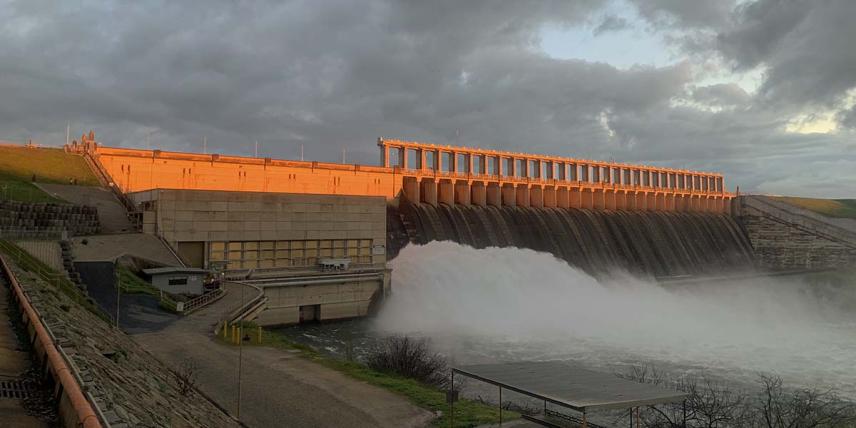During times of flood and high releases you should stay up to date with the latest information from the Bureau of Meteorology.
Find all emergency contact information.
MDBA dam management
The MDBA manages major storages in the River Murray system, with the aim of making sure dam structures remain safe during floods.
- Find out more about the management of Hume dam during floods.
- Find out more about the management of Dartmouth dam during floods.
Not all dams in the Murray–Darling Basin are operated by the MDBA.
Basin states dam management
The states are primarily responsible for the management and operation of most storages across the Basin. The states have agencies and authorities to manage water with some of the responsibilities including maintaining dams and water storages outside the River Murray system.
There are several parts of the River Murray system that are not managed by the MDBA.
Menindee Lakes storage – WaterNSW manages the Menindee Lakes on behalf of the New South Wales State Government, including the management of flooding. However, under certain storage volumes there are operating rules which allow the MDBA to share the water in the Lakes as part of the Murray–Darling Basin Agreement.
Each state government has a body that is responsible for managing water and storages in the Basin not within the River Murray system. Some are state-owned, while others are statutory corporations which have been nominated by the state. These bodies are:
- WaterNSW – New South Wales
- Seqwater and Sunwater – Queensland
- SA Water – South Australia
- Goulburn–Murray Water – Victoria

Water releases from dams during flooding
The Murray–Darling Basin has a variable climate. This is a key reason why dams have been built in many catchments across the Basin to capture and supply water for communities, industries and the environment. These dams can also provide an opportunity to mitigate floods, depending on their particular design, and how much flood water they can capture when floods occur. This differs for each dam and also depends on:
- The size and duration of the flood
- How much empty capacity or ‘airspace’ is left in the dam when the flood occurs
Some dams also have additional, ‘designated’ airspace that is reserved for capturing water only during large floods. Dams without this capacity, such as Hume Dam provide very little flood mitigation when water approaches the full supply level. This is because most of the flood water entering the dam must be released downstream to prevent the dam level rising too high and risking dam safety.
At Hume Dam, many floods require very little release of water downstream because the dam is still filling, and significant airspace remains to capture the flood. This happens in about 70% of Hume Dam floods.
However, Hume Dams primary purpose is to maximise water storage, not to mitigate floods.
In wetter years, Hume’s storage level will therefore increase and reach close to full if enough rain falls. In these years the MDBA will always release some extra water to delay the dam filling. This maintains some airspace to help capture and mitigate the peak of any flood that might follow. However, once conditions start to dry, these releases must be reduced to ensure as much water as possible is stored for future use, once flooding ends.
When Hume Dam’s storage level is high, airspace is constantly reviewed and smaller inflows will be released, with only limited flood mitigation, to maintain some airspace.
If further rain is forecast in the short term, releases may be increased to match the inflows even if the river downstream is already flowing at full capacity. By doing this, airspace is preserved in the dam, which maintains the safety of the dam and provides some ability to reduce any further flooding that may quickly follow.

Timing of water releases
Along the Murray and across the Basin, communities and the environment must adapt and respond to the effects of the region’s variable climate that swing between severe drought and intense rain and flooding. However, it is drought and the resultant shortage of water that impacts more profoundly and in a more long-lasting way – especially on the Basin’s economic prosperity.
This is why governments have instructed the MDBA to operate large dams such as Hume and Dartmouth to prioritise water security. In wetter years these dams are managed to increase water storage, preserve water for drier times and to meet downstream needs.
As dams rise towards full, the MDBA also considers the need to protect against flooding and if needed will release additional water prior to flooding. These releases help retain some empty capacity (airspace) in the dams to capture and mitigate floods – if they occur – as the dams near full capacity. It is important that the MDBA ensures that when water is released that the storages will be able to be filled to conserve water if dry conditions return.
When water is released, the amount calculated takes into consideration the rain forecasts that might re-start flooding in the near future, helping provide additional flood mitigation. However, large floods are difficult to predict more than a week in advance and with limited airspace, flood mitigation by the dam can only reduce the size of some large floods by a small amount.
When the storage is near full, large flood inflows must be passed downstream as they arrive to ensure the structural integrity and safety of the dam is maintained. This means that moderate to large floods below the dam will occur from time to time in the future, although less frequently than they did prior to the dam’s construction.
Last updated: 1 May 2025